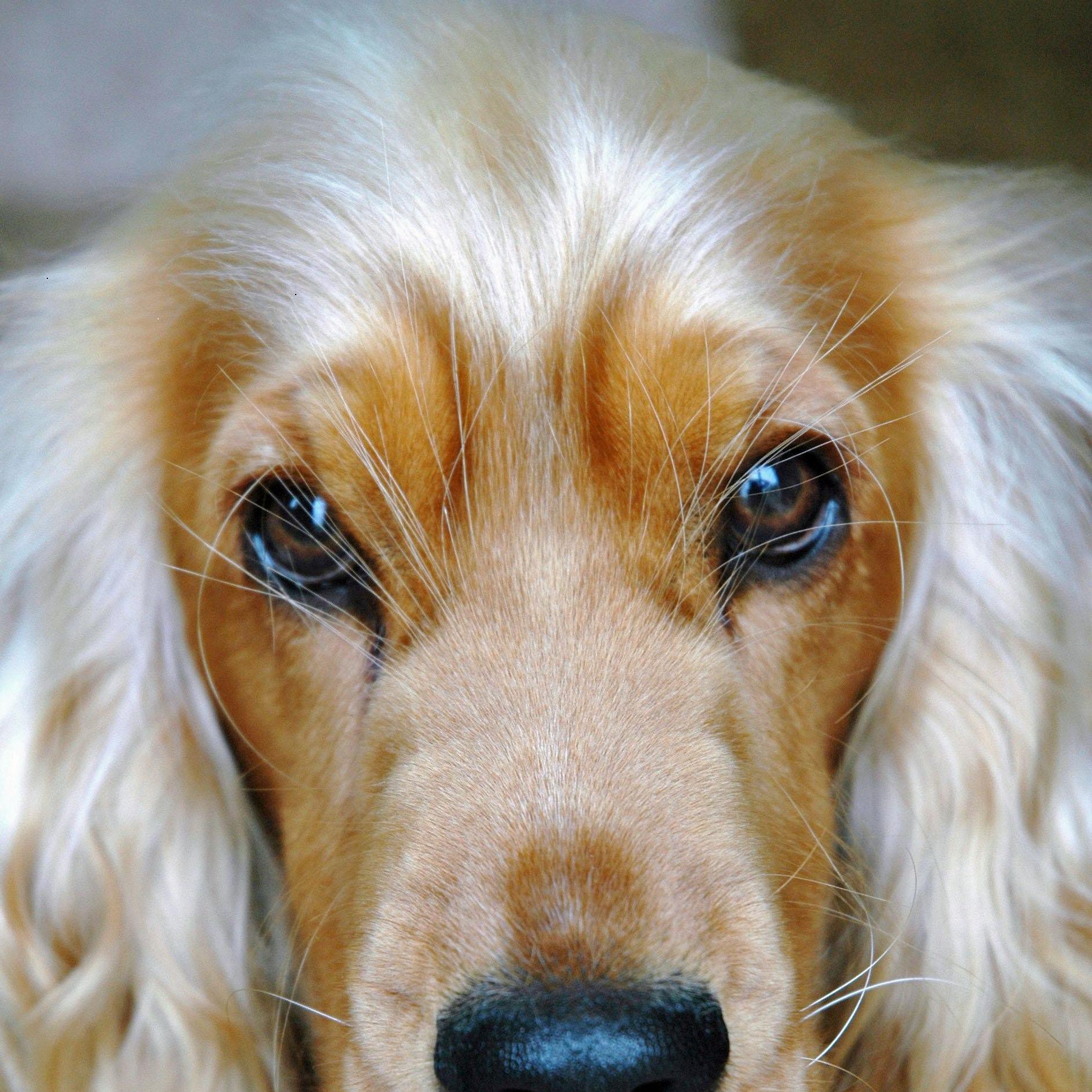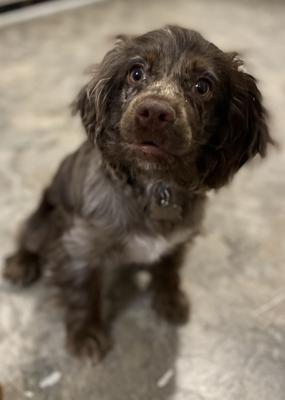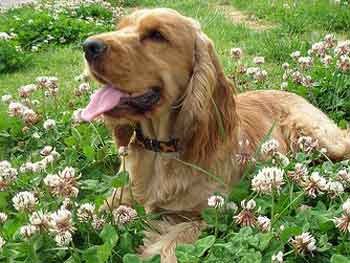- Home
- Cocker Spaniel eye problems
- Conjunctivitis in dogs
Conjunctivitis in Dogs
Learn all about Conjunctivitis in dogs (also known as Pink Eye). Know what signs to look for, causes, diagnosis and treatment. In fact, everything you need to keep your precious Cocker Spaniel's eyes healthy!
Conjunctivitis In Dogs: What Is It?
Canine conjunctivitis is an inflammation of the conjunctiva. This is the delicate transparent layer of tissue covering the front part of the eye, the inside of the eyelids, and your dog's third eyelid.
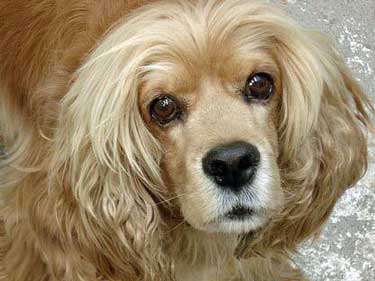 Conjunctivitis in dogs can be painful - thankfully, this Cocker is clear
Conjunctivitis in dogs can be painful - thankfully, this Cocker is clearThe purpose of the conjunctiva is to secrete nourishment and lubricants onto the eye.
Although this delicate membrane is transparent, it actually contains tiny blood vessels which, when inflamed, causes the eye to look swollen and bloodshot.
This condition is called conjunctivitis. You'll also hear it referred to as pink eye or red eye for obvious reasons.
What Causes Conjunctivitis in Dogs?
There are many different causes of pink eye in dogs, and your vet will try to work out which one he's dealing with so that he can treat it correctly.
Bacterial or Fungal Infections
Conjunctivitis in Cocker Spaniel can be caused by a bacterial or fungal infection.
If it's bacterial, the culprit is likely to be the streptococcus or staphylococcus bacterium.
If it's a viral infection, it could be a secondary condition of another problem such as canine distemper virus or some form of cold or flu virus.
Both bacterial and viral conjunctivitis are highly contagious.
The eye produces mucus and pus, often causing the eyelids to crust over.
If conjunctivitis in dogs isn't treated correctly and promptly, it can result in problems with the dog's eyesight. In rare cases, it can lead to a loss of vision.
Allergies
Conjunctivitis in dogs can also be caused by an allergic reaction to:
- pollen;
- dust or dust mites;
- mould;
- grass;
- cigarette or wood-smoke;
- household products;
- perfumes;
- a prescribed drug.
The allergic reaction causes the membrane to become swollen and pink and produces a watery discharge and itching.
It's usually present in both eyes at once, unless the conjunctivitis is caused by a grass seed, for example, which will only affect the eye it enters.
Because it's an allergic reaction specific to each pet, it's not contagious and is often seasonal.
Injury, Irritation Or Other Eye Condition
Inflammatory canine conjunctivitis can occur following an eye injury or irritation from a foreign body, such as a piece of grit or grass seed.
It can also come about as a result of another eye disease or problem, for example:
- dry eye (keratoconjunctivitis sicca (KCS));
- eyelid tumours (although rare);
- ulcerative keratitis;
- glaucoma;
- eyelash disorders such as distichiasis and ectopic cilia;
- entropion.
Neonatal Conjunctivitis in Dogs
Neonatal conjunctivitis is caused by a bacterial infection and affects young puppies, but it can also affect new born puppies, even though their eyes don't open until they're around 2 weeks old!
Neonatal conjunctivitis can be present in one or both eyes and can cause the eye to crust over, making it difficult to open.
If the pus has nowhere to drain, it builds up behind the eyelid and can cause swelling.
If the eyes are open, you'll see symptoms typically associated with pink eye: such as discharge, squinting, swelling, redness etc.
If the eyes are closed, the vet will bathe them with a warm solution and open them very carefully and gently.
Once opened, the eyes can be drained and treated with an antibiotic ointment.
Neonatal conjunctivitis in dogs can become serious if it's not treated quickly by a vet; it can result in damage to the cornea and, in grave cases, it can lead to blindness.
Symptoms of Conjunctivitis in Cocker Spaniels
Symptoms will vary depending on what's causing the problem and how inflamed the eyes are, but typically will often include:
- puffy, swollen, red eyelids;
- bloodshot eyes;
- runny eyes: a watery, pus, or mucous discharge;
- swollen eye tissue;
- closed eyes;
- squinting and blinking in one or both eyes;
- eyelids that stick together;
- the third eyelid becomes visible ;
- itching.
If you see your dog pawing at his eyes or trying to rub his face on anything he can get near to, it's probably because his eyes are very itchy.
Do your best to stop this because any rubbing could damage his eyes (more so than actual conjunctivitis). I think the best solution would be to fit him with an Elizabethan collar for protection.
Diagnosis And Testing
Your vet will be keen to determine what's causing your dog's conjunctivitis so that he can treat it successfully.
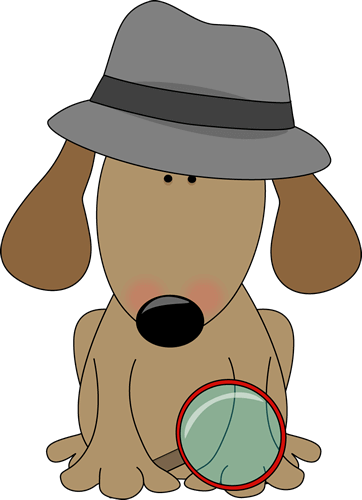 Just lookin' for clues!
Just lookin' for clues!He'll probably check your Cocker's history before carefully examining his eyes.
He'll be looking for signs of injury, a foreign body, eye disease and other clues to help with his diagnosis.
If your little guy is having difficulty keeping his eyes open, he may use anaesthetic drops to numb the surface of your pet's eyes so that he can get on with the examination without distressing your dog.
If it's a symptom of an underlying illness or eye disease, and he only treats conjunctivitis, the underlying problem will continue to develop. In addition, the problem will more than likely return.
It should be a case of 'treat the disease, not the symptom'.
Looking For Clues: Are Both Eyes Affected?
Conjunctivitis in dogs can affect either one or both eyes, depending on the cause, and this is where your vet will pick up valuable clues.
For example, if only one eye is affected with pink eye, it's unlikely to be caused by an allergy.
It's more likely to point to either a scratch or something in your dog's eye, in which case your vet may use a fluorescent dye which, under blue light, will highlight any foreign bodies, ulcers, or abrasions.
If conjunctivitis is present in both eyes, its cause is more likely to be a viral or bacterial infection, an allergy (to pollen, for example), or an environmental irritant, such as cigarette or wood smoke, or chemicals.
Looking for Clues: Type of Discharge
The type of discharge from the eye will give your vet some extra clues to help him diagnose the problem.
For example, if it's in both eyes and the discharge is clear and watery, an allergy may be the culprit.
If it's thick and mucous-like, it could suggest dry eyes or a fungal or bacterial problem.
Looking For Clues: Testing
Because conjunctivitis in dogs could be one of the symptoms of another eye disease, your vet will carry out a detailed eye examination to help rule this out.
As well as inspecting the eye itself, he may check tear ducts, lashes, eyelids (including the third eyelid), and the cornea.
He may decide to test for allergies, but it's more likely that he'll check for glaucoma and other serious eye diseases.
If a diagnosis proves difficult, the vet may take cells from the conjunctiva for examination under a microscope.
Once your vet has established that the problem is canine conjunctivitis, and he understands what's has caused it, he will recommend an effective treatment.
Treatment of Conjunctivitis in Dogs
Treating conjunctivitis in dogs very often depends on what's causing it, for example:
Bacterial Infection:
If it's a bacterial infection, your pet will need an antibiotic, which may be in the form of an injection, an ointment, or tablets.
Fungal Infection:
An anti-fungal ointment will be given for treatment of a fungal infection.
Viral Infection or Existing Eye Disorder:
The treatment will vary, depending on the condition. The vet will treat the actual eye condition causing conjunctivitis (for example, entropion or glaucoma). In the meanwhile, he will prescribe something to soothe the symptoms of the dog's conjunctivitis.
Allergy:
Treatment for canine conjunctivitis caused by an allergy usually involves flushing or washing the eye with a mild eyewash, preferably prescribed by your vet, but you can buy over-the-counter treatments too.
Your vet may also recommend antibacterial eye drops (with or without steroids, depending on how bad the condition is) to help reduce any inflammation.
He may also test for allergies to determine what's causing the allergy so that you can remove it from your pet's environment.
Injury or Irritants:
For scratches, abrasions or irritants, soothing eye drops may be all that is necessary.
Prevention of Canine Conjunctivitis
Whilst you may not be able to prevent it, there are a few common-sense precautions you can take to help lessen the possibility of your dog developing conjunctivitis.
Regular Eye Checks
As well as routine eye examinations with his vet, we can play our part by being vigilant by checking our Cocker's eyes when we're grooming or petting him.
Routine Eye Cleaning
I check and clear Max's eyes every morning. They're usually okay, maybe a little 'gunk' in the corner of one eye, but I take the time to remove it.
He has a blocked tear duct (which unfortunately can't be un-blocked), so his eye waters from time to time and, as it has nowhere to drain, it runs out of the corner of his eye and onto his fur, leaving a wet streak.
It's not really a problem, and it causes Max no harm, but I try to keep this area wiped dry and clean.
I clean his eyes each week as part of his grooming routine.
Allergies and Irritants
Wherever possible, keep your Cocker Spaniel away from potential allergens and irritants, such as chemicals, dust, pollen, smoke, grasses, corn and wheat.
I've lost count of the number of times Max has been to the vet's surgery to have a seed or a piece of chaff removed from his ear!
I don't want to be a party-pooper, but don't let your dog ride in the car with his head poking out of the window. I suspect we've all been guilty of that at some time, but it's a recipe for disaster.
He could get hit (or stung) in the eye by an insect, grit and other airborne nasties. It's just not worth the risk.
I realize there's only so much we can do to protect our pets from allergens and irritants.
They're Cocker Spaniels, for goodness sake!
They love to romp around in fields and the undergrowth. Dogs will be dogs, and we can't wrap them in cotton wool, but we can at least try anyway, can't we?
Vaccination
By staying up to date with all vaccinations, we can protect our pets against other canine diseases that can cause conjunctivitis, such as distemper - one less thing to worry about!
Canine Conjunctivitis: Summary
So, whilst we can't actually prevent conjunctivitis in dogs, there are things that we can do to reduce the risk for our pets.
Staying in touch with the vet and making sure your pet has regular eye examinations is the first step towards catching eye problems early, so make sure your Spaniel sees his vet at least once a year.
You can play your part too, by checking your pet's eyes daily. Clear any gunk from the corners and gently wipe around the eye area using a piece of cotton wool soaked in saline solution or an eye cleaner recommended by your vet.
Keep the dreaded pink eye at bay!
Visitor Questions: Conjunctivitis in Dogs
Eye Irritation in My Cocker Spaniel
By Alta Ellis
Reno, NV 89433
My dog gets crusty eyes, and one eye is much worse than the other. I've tried eye antibiotics and they still get gooey.
Does anyone have any idea of what this is and how I should treat it?
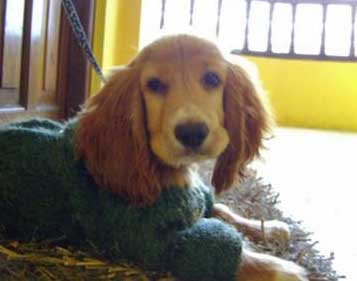 No more conjunctivitis for this little puppy!
No more conjunctivitis for this little puppy!Reply from Pauline (Website Owner)
Hi Alta,
Where the discharge is runny and watery, it may be allergy-related, for example; pollen, or other air-born particles.
However, if your dog's eyes are gloopy and/or crusty, he may have an eye infection or a condition such as conjunctivitis or dry eye.
Conjunctivitis is a fairly common eye problem in dogs and is sometimes referred to as pinkeye.
It's where the inside of the eyelid becomes inflamed, causing the eyes to weep or itch, and a yellow, grey or green discharge may form a crust over the eye.
If you believe your dog has an eye infection, the best thing you can do is arrange to take your dog to see his vet. However, there are some things you can do to keep infection at bay and/or relieve any discomfort from an existing eye infection.
Keeping your dog's eyes clean is the first step, and depending upon the severity of the problem, you may need to clean your dog's eyes up to three times a day.
Use cotton wool soaked in either a saline solution (half a teaspoon of salt dissolved in one cup of distilled water), normal distilled water or, if your dog's eyes are dry, olive oil.
Gently wipe across your dog's eyes from the inside out.
Use a clean one for each eye to avoid cross-infection, and be very careful not to scratch or touch your dog's eyeball.
You can learn more about dog eye problems and what to do about them here.
Eye problems, such as conjunctivitis in dogs, can also point to an underlying illness, so it really is essential that you arrange a trip to the vets if your dog develops any eye infections.
Visitor Comments:
Eye Irritation in My Cocker Spaniel
By: Anonymous
My dog had gloopy eyes last year (yeah, both of them!), and when I took him to the vets, I was told he had conjunctivitis in both eyes.
I think it was transferred from one eye to the other because, at first, he only had the infection in one eye.
My vet showed me how to check his eyes and how to clean them.
I was to look at them every day and remove any gunk out of the corner of his eyes, using either a clean finger or a piece of dampened lint-free cloth.
I was given drops to clean up the infection, but I think you can get unmedicated eye drops that can be used daily or weekly.
He also said that the whites of his eyes should be white and clear and that any pink or redness was a sign that all was not well.
I check my dog's eyes every day now, and it's become a habit and is no big deal.
Hope your dog's eyes are better now!
Photo Credit: Conjunctivitis in Dogs
1. Photo of Dog detective: My Cute Graphics


